Avian influenza, commonly referred to as bird flu, is a highly contagious viral infection that primarily affects birds. The abbreviation AI is often used in scientific and medical literature, but for the purpose of this article, we will refer to it by its full name. This disease has gained significant attention due to its potential to cause outbreaks in poultry and, in rare cases, spread to humans. Understanding its causes, symptoms, and prevention methods is crucial for safeguarding public health and the agricultural industry.

Overview of Avian Influenza
Avian influenza is caused by a group of viruses that belong to the Orthomyxoviridae family. These viruses are classified into various subtypes based on two proteins found on their surface: hemagglutinin and neuraminidase. While most strains of avian influenza primarily infect birds, some subtypes have been known to cross the species barrier and infect humans, causing serious illness.
The disease was first identified in Italy more than a century ago, but it has since spread across the globe. Outbreaks in poultry can result in significant economic losses due to high mortality rates among infected birds and the need for mass culling to prevent further spread. In humans, avian influenza infections are rare but can be severe or even fatal, particularly when caused by certain subtypes such as H5N1 and H7N9.
How Avian Influenza Spreads
Avian influenza spreads primarily through direct contact with infected birds or their droppings. The virus can also be transmitted indirectly through contaminated surfaces, equipment, or water sources. Wild birds, especially migratory species, play a critical role in spreading the virus over long distances. Domesticated birds, such as chickens, ducks, and turkeys, are particularly vulnerable to infection when exposed to the virus.
Causes of Avian Influenza
The root cause of avian influenza lies in the presence of specific viruses that thrive in bird populations. These viruses are constantly evolving, which makes them challenging to control. Several factors contribute to the emergence and spread of avian influenza:
- Viral Mutation: The avian influenza virus can mutate rapidly, leading to new strains that may be more virulent or capable of infecting different species.
- Poor Biosecurity Measures: Inadequate hygiene and biosecurity practices in poultry farms increase the risk of virus transmission.
- Migratory Birds: Wild birds, particularly waterfowl, serve as natural reservoirs for the virus and can introduce it to domestic bird populations during migration.
- Live Bird Markets: Crowded conditions in live bird markets facilitate the spread of the virus among birds and pose a risk to humans who handle or purchase live poultry.
Role of Environmental Factors
Environmental factors such as temperature, humidity, and water availability can influence the survival and transmission of the virus. For example, the virus tends to survive longer in cooler and wetter conditions, making outbreaks more common during colder months. Additionally, poor sanitation in poultry farms and markets creates an ideal environment for the virus to thrive.
Symptoms of Avian Influenza
The symptoms of avian influenza vary depending on whether the infection occurs in birds or humans. Recognizing these symptoms is essential for early detection and intervention.
Symptoms in Birds
In birds, avian influenza can manifest in two forms: low pathogenic and highly pathogenic. Low pathogenic avian influenza typically causes mild symptoms, such as:
- Ruffled feathers
- Decreased egg production
- Mild respiratory issues
Highly pathogenic avian influenza, on the other hand, is far more severe and often leads to rapid death. Symptoms include:
- Sudden death without prior signs of illness
- Swelling of the head, comb, and wattles
- Diarrhea
- Difficulty breathing
- Nervous system disorders, such as tremors or paralysis
Symptoms in Humans
While human infections with avian influenza are rare, they can occur through close contact with infected birds or contaminated environments. The symptoms in humans resemble those of other respiratory illnesses and may include:
- Fever and chills
- Cough
- Sore throat
- Muscle aches
- Shortness of breath
In severe cases, the infection can lead to pneumonia, acute respiratory distress syndrome, and even death. The severity of the illness depends on the subtype of the virus and the individual’s immune response.
Prevention of Avian Influenza
Preventing the spread of avian influenza requires a combination of strategies aimed at reducing exposure to the virus and enhancing biosecurity measures. Both individuals and governments play a critical role in minimizing the risk of outbreaks.
Biosecurity Measures in Poultry Farms
Implementing strict biosecurity protocols is one of the most effective ways to prevent avian influenza outbreaks in poultry farms. Key measures include:
- Restricting Access: Limiting access to poultry farms to authorized personnel only can reduce the risk of introducing the virus.
- Proper Hygiene: Ensuring that workers wash their hands and disinfect footwear before entering poultry areas helps prevent contamination.
- Separation of Species: Keeping different species of birds separate reduces the likelihood of cross-infection.
- Vaccination: Vaccinating poultry against specific subtypes of avian influenza can provide partial protection and reduce the severity of outbreaks.
Public Health Measures
To protect human populations from avian influenza, public health authorities recommend the following measures:
- Avoiding Contact with Sick Birds: Individuals should avoid handling sick or dead birds, especially in areas where avian influenza outbreaks have been reported.
- Cooking Poultry Thoroughly: Properly cooking poultry and eggs to an internal temperature of at least 165 degrees Fahrenheit kills the virus and ensures food safety.
- Surveillance and Reporting: Governments and health organizations must monitor bird populations for signs of infection and promptly report any suspected cases to relevant authorities.
International Collaboration
Given the global nature of avian influenza, international collaboration is essential for controlling its spread. Sharing information about outbreaks, conducting joint research, and coordinating responses can help mitigate the impact of the disease. Organizations such as the World Health Organization and the Food and Agriculture Organization play a vital role in facilitating these efforts.
Education and Awareness
Educating farmers, veterinarians, and the general public about avian influenza is another critical component of prevention. Awareness campaigns can inform people about the risks associated with the disease and teach them how to recognize symptoms and take appropriate action. By fostering a culture of vigilance and responsibility, communities can work together to minimize the threat posed by avian influenza.





